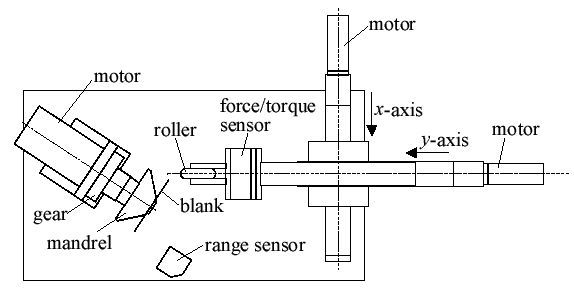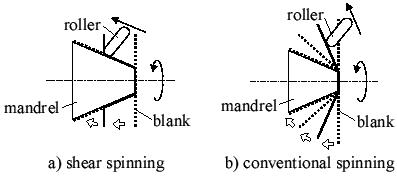This study seeks to exploit robot control techniques such as force feedback control for metal spinning. We aim to develop flexible and intelligent forming processes, and to expand a new application area for robot control.
Metal spinning
Metal spinning is a plasticity forming process that forms a metal sheet or tube by forcing the metal onto a rotating mandrel using a roller or a paddle tool. It is widely used for producing round hollow metal parts and products, e.g. tableware, kitchenware, ornaments, lighting fixtures, parabola antennas, boilers, tanks, gas canisters, nozzles, engine parts, and tire wheels. This forming process is also known as a highly-skilled manufacturing craft by artisans that requires decades of experience. Even nose cones for H-IIA space rockets launched by JAXA in Japan are produced by such manual metal spinning.

Metal spinning has several merits over other metal forming processes as follows.
It can create more complicated shapes than sheet metal stamping or deep drawing.
As it needs only one mandrel, it is easier to set up for forming.
Forming force is rather small and the forming apparatus can be compact.
Material can be saved in comparison with cutting processes.
It can provide precision products and good surface finishing.
These merits agree with recent trends in production technologies such as rapid prototyping and net shape manufacturing. Metal spinning can also be regarded as one of the incremental forming processes, which have been recently receiving attention in plasticity forming technologies.
However, progress in automated metal spinning is rather slower than in other areas of plasticity forming. Although numerically controlled spinning machines can achieve mass production of simple-shaped products, the programming of the machines depends greatly on skilled operators. Scientific research on metal spinning, mainly in production and material engineering, also does not seem very active. The mechanism of deformation is three-dimensional and too complicated for computer simulations. There are many control parameters and it requires the development of experimental setups. Consequently, the mechanics of the forming process have not been sufficiently clarified. In particular, forming procedures for {\it conventional spinning} have not been theoretically established. In fact, practical production depends on the experience of skilled workers.
Robotics research and manufacturing applications
In recent years, studies on industrial robots for manufacturing applications tend to be less and less active while most academic researchers are inclined towards non-manufacturing applications. In consequence, applications for industrial robots have not varied much from the conventional handling, assembly, welding and painting. Some researchers even consider industrial robots as mature or old-fashioned technology since they only take notice of such applications.
Current industrial robots are generally used for simple repetitive tasks of low added value, which substitute for unskilled factory workers. Such robots have value only if they are less expensive and used in mass production to achieve higher speed and yield. However, mass production is not the only form of operation in manufacturing industries. There are various types of manufacturing crafts that only experienced artisans can perform. Such crafts are usually of small quantity but can create high value added products. A new market for robot technologies might develop if robotics researchers were attracted to such areas, utilizing the potentials of accumulated techniques, e.g. sensory feedback control, to achieve valuable application tasks for which even expensive intelligent robots can be worthwhile.
Metal spinning using robot technology
Force feedback control of manipulators has been studied in robotics for many years. We now have a variety of theoretical and experimental knowledge on hybrid position/force control, impedance control, etc. However, these techniques have not been widely applied in practice except for only a few kind of tasks such as assembly and grinding. We must still seek effective applications for these control methods.
Metal spinning appears to be a suitable task for an industrial robot for several reasons. In manual metal spinning, the various senses of the worker, particularly force feeling via the tool, play an important role. Metal spinning needs much smaller forming force than other plasticity forming techniques, on the order of kilograms instead of tons, because it is based on local deformation. It involves many control parameters and needs dexterous motion with multiple degrees of freedom. It is suitable for limited production of a wide variety and is a process of high added value, which we can see from the fact that even manual production can be viable as a manufacturing business. Thus it is expected that the profitability of a force controlled industrial robot can be high.
In this research, we aim to make metal spinning more flexible and intelligent, by introducing robot control technologies, such as force control, into the forming process. The forming conditions are modified in real time based on feedback of the forming status to avoid forming defects and to obtain high-quality products.
Conventional robot tasks are mainly composed of moving an object. In contrast, this research encounters the novel aspects of transforming an object. We expect that challenging research subjects may develop from this research while utilizing the potentials of robot technologies developed so far.

Copyright © Jiangsu Hoston Machine Tools Co., Ltd. (Hongkong Hoston Group CO., LIMITED)All Rights Reserved | Sitemap Technical Support: 